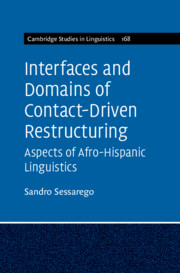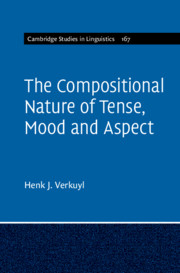Refine search
Actions for selected content:
6584 results in Grammar and Syntax

Interfaces and Domains of Contact-Driven Restructuring
- Aspects of Afro-Hispanic Linguistics
-
- Published online:
- 21 October 2021
- Print publication:
- 04 November 2021
List of Tables
-
- Book:
- The Compositional Nature of Tense, Mood and Aspect
- Published online:
- 08 October 2021
- Print publication:
- 14 October 2021, pp xvi-xvi
-
- Chapter
- Export citation
Dedication
-
- Book:
- The Compositional Nature of Tense, Mood and Aspect
- Published online:
- 08 October 2021
- Print publication:
- 14 October 2021, pp vii-viii
-
- Chapter
- Export citation
Subject Index
-
- Book:
- The Compositional Nature of Tense, Mood and Aspect
- Published online:
- 08 October 2021
- Print publication:
- 14 October 2021, pp 325-330
-
- Chapter
- Export citation
4 - Naive Physics and Aspectual Composition
-
- Book:
- The Compositional Nature of Tense, Mood and Aspect
- Published online:
- 08 October 2021
- Print publication:
- 14 October 2021, pp 93-130
-
- Chapter
- Export citation
8 - Tense, Mood and Aspect
-
- Book:
- The Compositional Nature of Tense, Mood and Aspect
- Published online:
- 08 October 2021
- Print publication:
- 14 October 2021, pp 253-289
-
- Chapter
- Export citation
7 - How to Deal Binarily with ...?
-
- Book:
- The Compositional Nature of Tense, Mood and Aspect
- Published online:
- 08 October 2021
- Print publication:
- 14 October 2021, pp 211-252
-
- Chapter
- Export citation
2 - How to Deal with the Long Tradition of Going Ternary?
-
- Book:
- The Compositional Nature of Tense, Mood and Aspect
- Published online:
- 08 October 2021
- Print publication:
- 14 October 2021, pp 12-47
-
- Chapter
- Export citation
Bibliography
-
- Book:
- The Compositional Nature of Tense, Mood and Aspect
- Published online:
- 08 October 2021
- Print publication:
- 14 October 2021, pp 301-320
-
- Chapter
- Export citation
3 - Binary Tense Structure
-
- Book:
- The Compositional Nature of Tense, Mood and Aspect
- Published online:
- 08 October 2021
- Print publication:
- 14 October 2021, pp 48-92
-
- Chapter
- Export citation
Contents
-
- Book:
- The Compositional Nature of Tense, Mood and Aspect
- Published online:
- 08 October 2021
- Print publication:
- 14 October 2021, pp ix-xiii
-
- Chapter
- Export citation
List of Figures
-
- Book:
- The Compositional Nature of Tense, Mood and Aspect
- Published online:
- 08 October 2021
- Print publication:
- 14 October 2021, pp xiv-xv
-
- Chapter
- Export citation
1 - Introductory Chapter
-
- Book:
- The Compositional Nature of Tense, Mood and Aspect
- Published online:
- 08 October 2021
- Print publication:
- 14 October 2021, pp 1-11
-
- Chapter
- Export citation
Appendix
-
- Book:
- The Compositional Nature of Tense, Mood and Aspect
- Published online:
- 08 October 2021
- Print publication:
- 14 October 2021, pp 290-300
-
- Chapter
- Export citation
Frontmatter
-
- Book:
- The Compositional Nature of Tense, Mood and Aspect
- Published online:
- 08 October 2021
- Print publication:
- 14 October 2021, pp i-vi
-
- Chapter
- Export citation
Preface
-
- Book:
- The Compositional Nature of Tense, Mood and Aspect
- Published online:
- 08 October 2021
- Print publication:
- 14 October 2021, pp xvii-xx
-
- Chapter
- Export citation
Author Index
-
- Book:
- The Compositional Nature of Tense, Mood and Aspect
- Published online:
- 08 October 2021
- Print publication:
- 14 October 2021, pp 321-324
-
- Chapter
- Export citation
6 - Binary Tense Structure and Adverbial Modification
-
- Book:
- The Compositional Nature of Tense, Mood and Aspect
- Published online:
- 08 October 2021
- Print publication:
- 14 October 2021, pp 169-210
-
- Chapter
- Export citation
5 - Levels of Interaction between Aspect and Tense
-
- Book:
- The Compositional Nature of Tense, Mood and Aspect
- Published online:
- 08 October 2021
- Print publication:
- 14 October 2021, pp 131-168
-
- Chapter
- Export citation

The Compositional Nature of Tense, Mood and Aspect
-
- Published online:
- 08 October 2021
- Print publication:
- 14 October 2021
